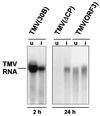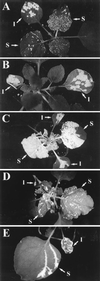A plant virus-encoded protein facilitates long-distance movement of heterologous viral RNA
- PMID: 9990003
- PMCID: PMC15442
- DOI: 10.1073/pnas.96.4.1212
A plant virus-encoded protein facilitates long-distance movement of heterologous viral RNA
Abstract
Transport of plant viruses from cell to cell typically involves one or more viral proteins that supply specific cell-to-cell movement functions. Long-distance transport of viruses through the vascular system is a less well understood process with requirements different from those of cell-to-cell movement. Usually viral coat protein (CP) is required for long-distance movement, but groundnut rosette umbravirus (GRV) does not code for a CP. However, this virus moves efficiently from cell to cell and long distance. We demonstrate here that the protein encoded by ORF3 of GRV can functionally replace the CP of tobacco mosaic virus (TMV) for long-distance movement. In spite of low levels of virus RNA accumulation in infected cells, chimeric TMV with a replacement of the CP gene by GRV ORF3 was able to move rapidly through the phloem. Moreover, this chimeric virus complemented long-distance movement of another CP-deficient TMV derivative expressing the gene encoding the green fluorescent protein. Thus, the GRV ORF3-encoded protein represents a class of trans-acting long-distance movement factors that can facilitate trafficking of an unrelated viral RNA.
Figures



Similar articles
-
Host-specific cell-to-cell and long-distance movements of cucumber mosaic virus are facilitated by the movement protein of groundnut rosette virus.Virology. 1999 Jul 20;260(1):98-108. doi: 10.1006/viro.1999.9806. Virology. 1999. PMID: 10405361
-
Intracellular location of two groundnut rosette umbravirus proteins delivered by PVX and TMV vectors.Virology. 1998 Mar 15;242(2):303-13. doi: 10.1006/viro.1997.9025. Virology. 1998. PMID: 9514976
-
An umbraviral protein, involved in long-distance RNA movement, binds viral RNA and forms unique, protective ribonucleoprotein complexes.J Virol. 2003 Mar;77(5):3031-40. doi: 10.1128/jvi.77.5.3031-3040.2003. J Virol. 2003. PMID: 12584328 Free PMC article.
-
Role of plant virus movement proteins.Methods Mol Biol. 2008;451:33-54. doi: 10.1007/978-1-59745-102-4_3. Methods Mol Biol. 2008. PMID: 18370246 Review.
-
[Current situation and prospect of studies on genus Umbravirus].Wei Sheng Wu Xue Bao. 2006 Dec;46(6):1033-7. Wei Sheng Wu Xue Bao. 2006. PMID: 17302177 Review. Chinese.
Cited by
-
Reduced susceptibility to a tobacco bushy top virus Malawi isolate by loss of function in host eIF(iso)4E genes.Breed Sci. 2020 Jun;70(3):313-320. doi: 10.1270/jsbbs.19135. Epub 2020 May 19. Breed Sci. 2020. PMID: 32714053 Free PMC article.
-
Defense Responses Induced by Viral Movement Protein and Its Nuclear Localization Modulate Virus Cell-to-Cell Transport.Plants (Basel). 2024 Sep 11;13(18):2550. doi: 10.3390/plants13182550. Plants (Basel). 2024. PMID: 39339524 Free PMC article.
-
Coilin, the signature protein of Cajal bodies, differentially modulates the interactions of plants with viruses in widely different taxa.Nucleus. 2014 Jan-Feb;5(1):85-94. doi: 10.4161/nucl.28315. Epub 2014 Feb 24. Nucleus. 2014. PMID: 24637832 Free PMC article.
-
The Cajal Body in Plant-Virus Interactions.Viruses. 2020 Feb 23;12(2):250. doi: 10.3390/v12020250. Viruses. 2020. PMID: 32102236 Free PMC article. Review.
-
Sieve elements and companion cells-traffic control centers of the phloem.Plant Cell. 1999 Apr;11(4):739-50. doi: 10.1105/tpc.11.4.739. Plant Cell. 1999. PMID: 10213790 Free PMC article. No abstract available.
References
LinkOut - more resources
Full Text Sources
Other Literature Sources
Miscellaneous

